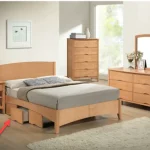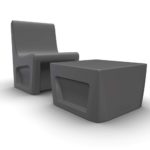Ligature-Resistant Furniture = Greater Peace of Mind

Perhaps the most heartbreaking and tragic situation that can take place in a treatment center is patient suicide. And while it is just not possible to prevent every attempt at self-harm, progress toward minimizing these acts is being made. One important factor in the fight against self-harm is to use ligature-resistant furniture.
The Joint Commission defines ligature-resistant furniture as, “without points where a cord, rope, bedsheet, or other fabric/material can be looped or tied to create a sustainable point of attachment that may result in self-harm or loss of life.” Some ligature examples might include bedframes, cabinet handles, hinges and closures. Yet this technical definition doesn’t come close to expressing the true value of ligature-resistant furniture: greater peace of mind for families, concerned professionals, and treatment center employees. And while safety is priority #1, treatment center leaders must also assess ligature risks in the context of accreditation.
Ligature-related injuries or deaths are among the top sentinel events reported to the Joint Commission. Over the last five years, approximately 85 suicides were reported each year to the accrediting body as sentinel events.
In fact, the Joint Commission has redoubled its efforts in recent months to document any observable ligature points, no matter how small, during its accreditation surveys. Risks are designated as immediate “Recommendations for Improvement” by the commission, with correction timelines for the provider of just 60 days. This means addressing furniture choice as a key element of patient safety.
Contract furniture allows treatment centers to offer improved safety for patients and reduced liability for the business. A spectrum of options can allow providers to choose custom pieces, based on the treated population’s needs, from low- to moderate- to high-risk.
Leaders must not only consider the value of ligature-resistant furniture for patient safety, but as it affects their accreditation status. With both aspects in mind, a treatment center can continue to do perform its mission: providing excellent patient care and healing help.
Topics: Health Care Furniture, anti-contraband furniture, Behavioral Healthcare Furniture, heavy use furniture, heavy duty furniture, high-Risk Environments, ligature-Resistant Furniture, safe furniture

















